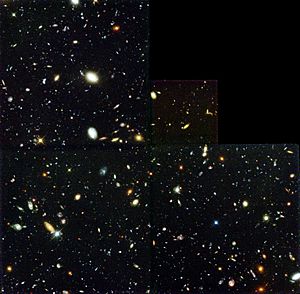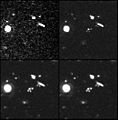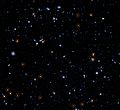Hubble Deep Field facts for kids
The Hubble Deep Field, often called the HDF, is a very special picture of a tiny part of the night sky. The Hubble Space Telescope took this image in 1995. It looked towards the constellation called Ursa Major.
This picture is super important! It shows over 3,000 galaxies. Many of these are some of the oldest and farthest away galaxies ever seen.
The part of the sky the HDF shows is incredibly small. It's less than one-tenth the width of a full Moon in the sky. Yet, it's packed with thousands of galaxies!
Light from these distant galaxies takes a very long time to reach Earth. Because of this, many galaxies in the picture look exactly as they did over 10 billion years ago. This allows scientists to see what the Universe was like back then. They can also study how it changed to become what it is today.
Scientists believe the Universe looks pretty much the same in every direction when you look at large areas. This idea, called the cosmological principle, makes the HDF a very useful tool. Astronomers use it to study how the Universe has changed over time.
Because of all these reasons, some people call the HDF 'the most important image ever taken'.
Images for kids
-
The HDF is at the centre of this image of one degree of sky. The Moon as seen from Earth would fill roughly one quarter of this image.
-
Diagram illustrating comparative sampling distance of the HDF and the 2004 Hubble Ultra-Deep Field
-
A section of the HDF about 14 arcseconds across in each of the four wavelengths used to construct the final version: 300 nm (top left), 450 nm (top right), 606 nm (bottom left) and 814 nm (bottom right)
-
Deep field image taken by ALMA and Hubble.
-
The HDF imaged by the Spitzer Space Telescope. The top segment shows the foreground objects in the field; the bottom shows the background with the foreground objects removed.
See also
 In Spanish: Campo Profundo del Hubble para niños
In Spanish: Campo Profundo del Hubble para niños









